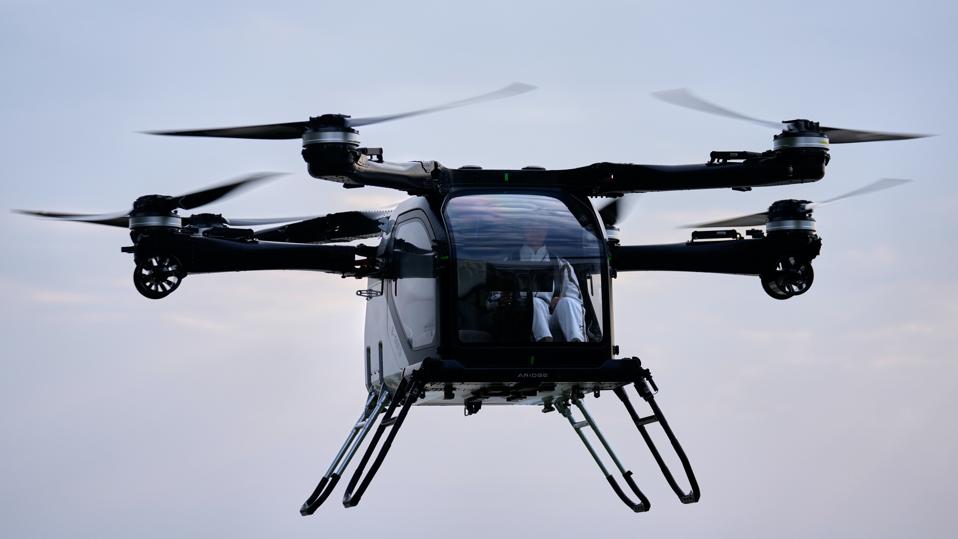|
Getting your Trinity Audio player ready...
|
China has been investing heavily in developing electric vertical takeoff and landing (eVTOL) aircraft for what it calls its Low-Altitude Economy (LAE). According to reports by the non-profit Vertical Flight Society (VFS), more than 100 Chinese eVTOL designs have been built over the past several years. Like a Cambrian explosion, eVTOL designs for small cargo delivery or carrying one or two passengers, as well larger eVTOL aircraft with up to six seats, are being designed by companies and universities in all manner of configurations. Most are supported by funding from China’s central, regional or municipal governments (with expectations to transcend the country’s notorious road congestion) as well as a strong desire to export Chinese eVTOL aircraft technology to the world, as it has with automotive electric vehicles (EVs).
Aridge

The eVTOL arm of Chinese electric vehicle (EV) company XPeng, Aridge, made several announcements in the United Arab Emirates (UAE) on Oct. 12, including the first public flight outside China of the X3-F eVTOL aircraft module of its Land Aircraft Carrier (LAC) automobile in Dubai. The LAC resembles a minivan version of the Tesla Cybertruck, with twin rear wheel designed to carry the load of the detachable two-seat X3-F, which has two-bladed propellers on six arms that fold out after extraction from the “mothership” EV. XPeng’s teaser video shows Emiratis driving the plug-in hybrid LAC to a remote destination, then taking a short sightseeing flights in the X3-F.
Aridge (alluding to “air” and “bridge”) expects its first exports to the Middle East in 2027. Its new Guangzhou factory will produce up to 10,000 vehicle pairs annually, and XPeng is considering a production or assembly site in the UAE. The company has received 7,000 orders for its LAC, including about 600 in the Middle East. Priced around US$270,000 in China, it costs less than a typical private airplane or helicopter (and comes with a car included!).
XPeng is a rapidly growing Chinese EV company, having delivered nearly 900,000 electric cars since 2018, including 40,000 EVs in September alone. In 2020, XPeng bought a small eVTOL company, Guangdong Huitian Aerospace Technology, that had built a series of 1–2-seat eVTOL demonstrators, calling the subsidiary HT Aero and, later, AeroHT. Over the past decade, AeroHT/Aridge has flown at least 16 different models, according to the VFS World eVTOL Aircraft Directory.
MORE FOR YOU
Full Moon November 2025: When To See The Biggest Supermoon Since 2019
The Top 10 Richest People In The World | November 2025
The 5 Best Water Flossers Worth Buying, Based On Our Testing
At the Dubai event, Aridge announced it was also developing a much larger aircraft, the A868, a high-speed, long-range eVTOL with six tilting propellers (not unlike Joby Aviation’s S4 eVTOL) with a hybrid-electric powertrain. The A868 seats six, can fly more than 500 km (310 miles) and has a top speed of more than 360 km/h (225 mph).
EHang

The most well-known Chinese eVTOL company is Guangzhou-based EHang. It earned its type certificate (TC) for design approval, production certificate (PC) for manufacturing authorization and airworthiness certificate (AC) for individual aircraft from the Civil Aviation Administration of China (CAAC) for its EH216-S Autonomous Air Vehicle (AAV), which has two seats and 16 lifting propellers (hence the name) on eight arms. The TC was awarded on Oct. 12, 2023, which made it the first type-certificated eVTOL aircraft in the world — and the first passenger-carrying autonomous aircraft — and two years later, it remains the world’s only passenger-carrying eVTOL with a TC.


